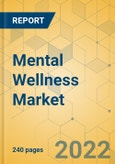Speak directly to the analyst to clarify any post sales queries you may have.
The global mental wellness market is expected to grow at a CAGR of 6.35% during the forecast period.
MARKET ENABLERS
- Increasing Awareness of Stress Management
- Growth in Individualized Self-Care
- Increase in Number of Working Hours
- Growing Cases of Depression
GLOBAL MENTAL WELLNESS MARKET SEGMENTATION
- In terms of market by disorder, the depression segment holds the highest revenue share in the market; it is also expected to grow at the highest growth rate at a CAGR of 7.97 % (by value) during 2022-2027, due to the increasing prevalence of depression and its associated effects across the world
- In terms of market by type, the senses spaces and sleep segment holds the highest revenue share in the market; while meditation and mindfulness is also expected to grow at the highest growth rate at a CAGR of 8.73 % (by value) during 2022-2027
- Based on age group the adult mental wellness segment dominated the market with a revenue share of 48.10% in 2021 and is expected to witness an absolute growth of 50.21% by the end of 2027
Segmentation by Disorder
- Depression
- Anxiety
- Schizophrenia
- Substance Use Disorder
- Bipolar Disorder
- Alcohol Use Disorder
- Post-Traumatic Stress Disorder
- Eating Disorder
- Others
Segmentation by Type
- Senses Spaces, And Sleep
- Brain Boosting Nutraceuticals & Botanicals
- Self-Improvement
- Meditation and Mindfulness
Segmentation by Age Group
- Adults
- Geriatric
- Teenager
GEOGRAPHICAL ANALYSIS
- North America region was the biggest revenue contributors in the global mental wellness market. It is also expected to witness the highest growth rate during the forecast period
- Factors such as the increased adoption of smartphones and tablets in developing countries have led to the increasing engagement of the population in mental wellness programs
Segmentation by Region
- North America
- US
- Canada
- APAC
- China
- Japan
- South Korea
- Australia
- India
- Europe
- Germany
- UK
- Italy
- France
- Spain
- Latin America
- Brazil
- Mexico
- Middle East & Africa
- South Africa
- Saudi Arabia
COMPETITIVE LANDSCAPE
- Global players like Skillpath, FranklinCovey, Amare Global, and Headspace are trying to expand their markets through profitable partnerships, whereas the domestic vendors are capitalizing with the product and services portfolio that best suits the domestic needs and wants
- Vendors compete in terms of service delivery, brand value, customization ability, price, skilled workforce, and technological capability as well. Most of the vendors offer mental wellness services and wellness portals. Vendors also tend to tie up with technology companies to develop mental wellness programs
Key Vendors
- SkillPath
- FranklinCovey
- Amare Global
- Headspace
Other Prominent Vendors
- CVS Health (Active Health)
- CuraLinc Healthcare
- Fitbit
- Wellsource
- Vitality
- Virgin Pulse
- Aduro
- HealthCheck360
- Lifestart
- Castlight
- Acadia Healthcare
- Calm
- Universal Health Services
- Behavioral Health Network
- Pyramid Healthcare
- Promises Behavioral Health
Table of Contents
Companies Mentioned
- SkillPath
- FranklinCovey
- Amare Global
- Headspace
- CVS Health (Active Health)
- CuraLinc Healthcare
- Fitbit
- Wellsource
- Vitality
- Virgin Pulse
- Aduro
- HealthCheck360
- Lifestart
- Castlight
- Acadia Healthcare
- Calm
- Universal Health Services
- Behavioral Health Network
- Pyramid Healthcare
- Promises Behavioral Health
Methodology
Our research comprises a mix of primary and secondary research. The secondary research sources that are typically referred to include, but are not limited to, company websites, annual reports, financial reports, company pipeline charts, broker reports, investor presentations and SEC filings, journals and conferences, internal proprietary databases, news articles, press releases, and webcasts specific to the companies operating in any given market.
Primary research involves email interactions with the industry participants across major geographies. The participants who typically take part in such a process include, but are not limited to, CEOs, VPs, business development managers, market intelligence managers, and national sales managers. We primarily rely on internal research work and internal databases that we have populated over the years. We cross-verify our secondary research findings with the primary respondents participating in the study.

LOADING...








